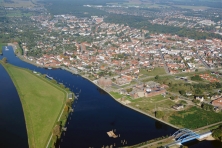Take Part in Wittenberge
Wittenberge (DE) - Mentionné
DONNÉES DE L'ÉQUIPE
Représentant d'équipe : Javier de Andrés de Vicente (ES) – architecte ; Associés : Blanca Alonso González (ES), Miguel Fernández-Galiano Rodríguez (ES), Miguel González Castro (ES), Angela Juarranz Serrano (ES), Marta Peña Lorea (ES), Ana Asuncion Perez Frade (ES), Marta Sebastián López (ES), Regina Valle Viudes (ES) – architectes
c/ Silva 13, 28004 Madrid – España
+34 627 30 90 41 – silva.europan@gmail.com
Voir la liste complète des portraits ici
Voir la page du site ici

INTERVIEW (en anglais)
1. How did you form the team for the competition?
We are a group of colleagues from the Polytechnic University of Madrid that are used to working together in the development of architecture competitions. Most of us combine this work with Master Studies or other professional collaborations.
2. How do you define the main issue of your project, insisting on how you answered on this session main topic: adaptability and urban rhythms?
The main goal of the proposal is to recover the project site area, opening it to visitors and residents, so they can get the opportunity to live by the riverside. But revitalising currently unattractive public spaces needs a consideration on a broader scale than the immediate site environment.
In order to take part in the city it is necessary to connect the project site with the rest of the city, creating an interesting and attractive network of routes that will guide visitors and residents with easy signs through the city, linking Wittenberge’s principal places of interest.
Related to this network, empty plots can be found with no current use. The goal is to recover those places and turn them into temporary public spaces towards a changing city. These public spaces will be livened up with a flexible catalogue of mobile devices created by citizens in the workshops held in the Storehouses. Each neighbour can take part and the city improves through collective design.
3. How did this issue and the questions raised by the site mutation meet?
It is important to develop an open-free barrier space for bikes and pedestrians, connected to the city centre and attractive for a large age range, from seniors to children. The urban routes that will be planned throughout the city are used also to organise and connect all areas of the project site.
Therefore, the proposal is a double and complementary one: on one hand it suggests a management system involving public authorities, citizens and the private owners of the buildings. All of them will work together to define the best suited uses for each building helped by the opportunity activity study provided. On the other hand, these uses will be complemented by a flexible catalogue of specific actions to improve the quality of the public space linked to the existing buildings.

4. Have you already treated this issue previously and could you present some reference projects that inspired yours?
We believe that the real public space is a non-defined place where all kinds of activities are possible as long as they are based on the city and citizens needs. As a consequence, the final result is an open one, influenced by the different uses that will be implemented in the buildings surrounding the public space and the decisions taken by the agents involved in the process.
Nowadays, those ideas of flexibility and citizen participation, are developed in a lot of projects, for example in El Campo de Cebada in Madrid, by Zuloark, but it also appears in old ones, such as the playgrounds developed by Aldo van Eyck in multiple empty plots in Amsterdam during the last century.
5. Today –within the era of an economic crisis and sustainability– the urban-architectural project should reconsider its production method in time; how did you integrate this issue in your project?
The proposal is very sensitive about the possibility of being progressively executed. The stages proposed respond to hypothetical situations. The final aspect of the complex should always be determinated by the agents involved in the process -buildings owners, authorities and citizens preferences. Quoting Yona Friedman, we think in Architecture "with the people, by the people, for the people."
6. Is it the first time you have been awarded a prize at Europan? How could this help you in your professional career?
Yes, it is! We are very excited about it. In fact, it was the first time that we have joined this competition. It was a really good experience for all of us and we hope this will be a good push to our professional careers. We are looking forward to explore the potential of our strategy. It would be amazing that a possibility of implementation for our proposal arise during the meetings with the site representatives.